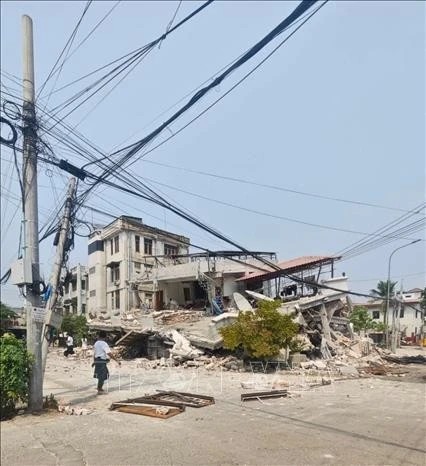 |
| A building lies in ruins following the devastating earthquake that struck Mandalay, Myanmar, on March 28, 2025. The photo captures the aftermath, showing the extent of the destruction caused by the natural disaster. (Photo: Xinhua/VNA) |
On the afternoon of March 28, Thai Prime Minister Paetongtarn Shinawatra declared a state of emergency in Bangkok after a powerful earthquake originating in Myanmar sent strong tremors across several countries in the region. The impact was significant, with a 30-story building under construction in Bangkok collapsing and trapping a minimum of 43 workers. Panic ensued as residents of high-rise buildings evacuated swiftly. The earthquake’s force temporarily halted several metro and skytrain lines. Chiang Mai also experienced strong tremors, prompting Prime Minister Shinawatra to cancel a scheduled trip to Phuket and convene an emergency meeting instead.
Yunnan province in China, which shares a border with Myanmar, recorded substantial tremors. According to Xinhua News Agency, residents of Kunming, the provincial capital, felt intense shaking, leading many to rush out of their homes. Fortunately, no immediate reports of casualties or damage have emerged from Yunnan in the aftermath.
The China Earthquake Networks Centre (CENC) measured the earthquake at a magnitude of 7.9, affecting Myanmar, China, and Thailand. The US Geological Survey (USGS) initially reported a 7.7-magnitude quake centered northwest of Sagaing, Myanmar, followed by a 6.4-magnitude aftershock.
In Vietnam, there have been no reports of direct impacts from the earthquake. However, residents in Hanoi, Ho Chi Minh City, and other areas, particularly those residing in high-rise apartments, reported experiencing mild tremors.
Experts caution that Myanmar’s rapid urbanization, coupled with weak infrastructure and disjointed urban planning, renders its densely populated cities increasingly susceptible to natural disasters. Additionally, the country’s healthcare system, particularly in rural areas, is already strained, presenting further challenges in disaster response and relief efforts.



